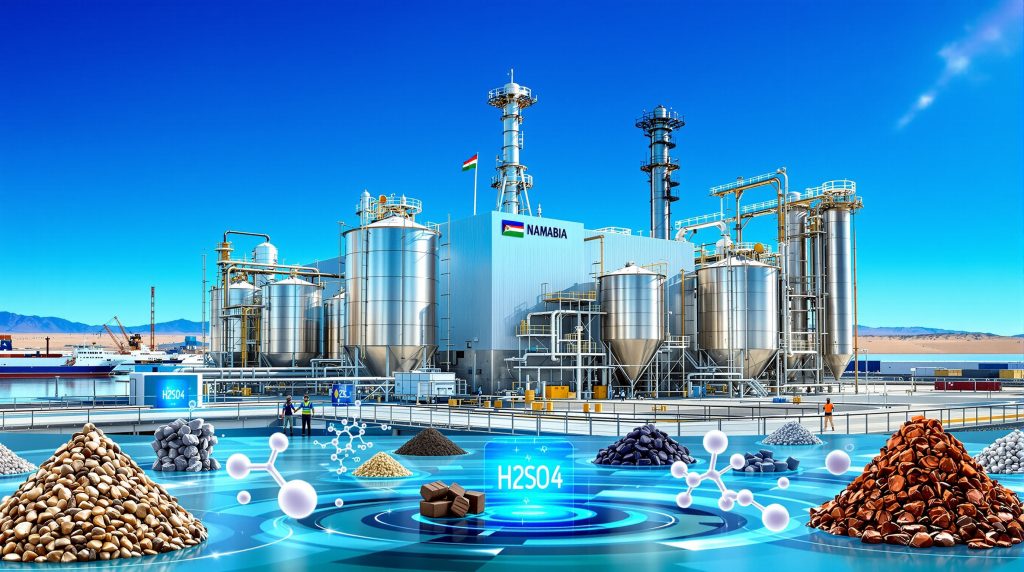Namibia's Sulphuric Acid Production Expansion: Supporting Critical Mineral Growth
Namibia is significantly ramping up its sulphuric acid production capacity through strategic investments, positioning itself as a critical minerals hub in the global supply chain. This expansion comes at a crucial time as the country develops its resources to meet growing global demand for minerals essential to the critical minerals transition.
How Is Namibia Boosting Its Sulphuric Acid Production?
Namibia's sulphuric acid production capacity is set to increase dramatically through two major initiatives. Green Metals Refining has announced plans to invest $59 million in the first phase of a new production facility in Walvis Bay, with an initial annual capacity of 175,000 metric tons. The company has designed this facility with scalability in mind, with plans to expand production to 720,000 tons annually as market demand increases.
Simultaneously, Vedanta is breathing new life into its previously idle sulphuric acid plant at the Skorpion zinc operations. This recommissioned facility will produce approximately 1,000 tons daily once operational, contributing roughly 365,000 tons annually to Namibia's production capacity.
"As Namibia is a net importer of sulphuric acid with a large pipeline of acid-consuming projects, we have established a compelling business case that can benefit local third-party metals projects," noted Green Metals Refining CEO Derk Hartman in a recent statement.
The timeline for these developments is relatively rapid, with Vedanta's plant expected to be operational within 4-6 months, while Green Metals' facility is scheduled for commissioning by the end of 2027.
Key Investment Details
- Green Metals Refining: $59 million initial investment for first phase
- Initial production capacity: 175,000 tons annually
- Ultimate production target: 720,000 tons annually at full capacity
- Vedanta's daily production:
1,000 tons (365,000 tons annually) - Facility locations: Green Metals in Walvis Bay port city; Vedanta at Skorpion zinc operations
- Timeline: Vedanta operational in 4-6 months; Green Metals by end of 2027
Why Is Sulphuric Acid Production Critical for Namibia's Mining Sector?
Sulphuric acid serves as an essential processing chemical for extracting various critical minerals. The acid is a fundamental component in leaching processes for uranium, copper, manganese, and rare earth elements—all crucial materials for clean energy technologies.
Namibia's position as the world's third-largest uranium producer makes reliable sulphuric acid supply particularly important. The uranium market dynamics directly impact extraction processes which typically use significant quantities of sulphuric acid in the leaching stage to separate uranium from ore.
Currently, Namibia imports much of its sulphuric acid requirements, creating supply chain vulnerabilities and increasing production costs for mining operations. Local production will address these challenges while potentially reducing the environmental footprint associated with long-distance transport of hazardous materials.
The acid's importance extends beyond uranium to other critical minerals that Namibia is developing, including copper projects and rare earth element deposits that are becoming increasingly valuable in the global transition to renewable energy technologies.
Critical Minerals Requiring Sulphuric Acid Processing
- Uranium: Used in leaching processes to extract uranium from ore
- Copper: Essential in oxide ore processing through heap leaching
- Manganese: Used in certain extraction processes
- Rare earth elements: Required for separation and processing
How Does This Expansion Support Namibia's Critical Minerals Strategy?
Namibia is strategically positioning itself as a critical minerals hub with eight active projects currently in development. The country's rich uranium reserves have already established it as the world's third-largest uranium producer, but its ambitions extend to other minerals essential for green energy technologies.
The expansion of domestic sulphuric acid production directly supports this strategy by addressing a key bottleneck in the mineral processing value chain. By securing reliable access to this essential input, Namibia can enhance the viability and competitiveness of its critical mineral projects.
This approach aligns with global trends toward securing supply chains for materials essential to the energy transition. By developing both the mineral resources and the processing inputs needed to extract them, Namibia is creating a more resilient and integrated critical minerals sector.
The timing is particularly strategic as global demand for critical minerals is projected to grow substantially in the coming decades, driven by the expansion of renewable energy, electric vehicles, and energy storage technologies.
Namibia's Critical Minerals Landscape
- Eight active critical minerals projects currently in development
- World's third-largest uranium producer with significant expansion potential
- Growing focus on copper, manganese, and rare earth elements
- Integrated approach linking mineral extraction with processing inputs
- Strategic positioning in global green energy mineral supply chains
What Are the Economic Benefits of Local Sulphuric Acid Production?
The development of domestic sulphuric acid production capacity provides multiple economic advantages for Namibia's mining sector and broader economy. By reducing reliance on imports, these facilities will improve supply security, potentially lower costs, and create new industrial jobs.
The economic impact extends beyond direct employment at the production facilities. By stabilizing input costs and improving supply reliability, local sulphuric acid production can enhance the economic viability of mining projects throughout the country, potentially attracting additional investment in the sector.
For mining operations, having a reliable local source of sulphuric acid reduces logistical complexities and costs associated with importing this hazardous material. This improvement in the operating environment can translate to more competitive production costs and potentially longer mine lives as lower-grade resources become economically viable to process.
Economic Advantages
- Reduced import dependency and associated logistical costs
- Enhanced supply chain security for mining operations
- Local job creation in manufacturing and logistics sectors
- Potential for export opportunities to neighboring countries
- Support for downstream processing and value addition activities
- Improved project economics for acid-dependent mining operations
- Attraction of additional investment in the critical minerals sector
How Will Green Metals Refining's Facility Integrate with Other Operations?
Green Metals Refining's sulphuric acid plant will be strategically co-located with their planned manganese refinery in Walvis Bay. This integrated approach creates operational efficiencies while positioning the facility to supply acid to third-party mining operations throughout the country.
The Walvis Bay location offers significant logistical advantages, providing access to port facilities for import of raw materials and potential export of finished products. This coastal position also facilitates efficient distribution to mining operations throughout Namibia.
The integration of the sulphuric acid plant with the manganese refinery represents a vertically integrated approach that enhances operational efficiency. By controlling both the processing input (sulphuric acid) and the primary production facility (manganese refinery), Green Metals can optimize operations and potentially realize cost savings.
Integration Benefits
- Co-location with manganese refinery creates operational synergies
- Strategic port location in Walvis Bay facilitates efficient logistics
- Ability to supply multiple mining operations across Namibia
- Reduced transportation costs and environmental impact
- Vertical integration enhancing operational control and efficiency
- Scalable design allowing expansion as demand increases
What Environmental Considerations Are Associated with Sulphuric Acid Production?
While sulphuric acid production is essential for mineral processing, it also presents environmental challenges that must be managed responsibly. Modern production facilities incorporate advanced emission control technologies and safety systems to minimize environmental impacts.
Sulphuric acid production typically generates sulfur dioxide emissions, which must be carefully controlled to prevent air quality impacts. Contemporary facilities employ scrubbing technologies and conversion processes that capture these emissions and incorporate them into the acid production process, significantly reducing atmospheric releases.
Water management represents another important environmental consideration. Acid production and storage require robust containment systems to prevent accidental releases that could impact water resources. Modern facilities incorporate multiple containment layers and monitoring systems to mitigate these risks.
Transportation of both raw materials and finished acid products also presents environmental and safety challenges. Local production reduces the distances acid must be transported, potentially reducing the overall environmental footprint and safety risks associated with moving hazardous materials.
Environmental Management Approaches
- Advanced emission control systems to minimize air quality impacts
- Multi-layer containment systems to prevent accidental releases
- Water management and recycling practices to reduce consumption
- Strict safety protocols for handling and transportation
- Continuous monitoring programs to ensure environmental compliance
- Reduced transportation distances compared to imported acid
- Energy efficiency measures to minimize carbon footprint
How Does This Development Compare to Regional Trends?
Namibia's sulphuric acid production expansion aligns with broader trends across southern Africa, where countries are increasingly investing in domestic production capacity to support growing mining sectors. This regional movement toward self-sufficiency in critical industrial chemicals strengthens the entire mining ecosystem.
Several other African nations with significant mining sectors, including Zambia and the Democratic Republic of Congo, have also invested in sulphuric acid production facilities to support their copper and cobalt industries. This regional trend reflects growing recognition of the strategic importance of securing processing inputs for critical mineral value chains.
The development of regional production capacity could potentially lead to intra-African trade in sulphuric acid, creating a more resilient regional supply network less dependent on overseas imports. This regional self-sufficiency aligns with broader continental strategies to increase value addition within Africa's resource sectors.
Regional Context
- Similar investments in sulphuric acid production across southern Africa
- Growing recognition of acid's importance in critical mineral supply chains
- Regional movement toward reduced reliance on international imports
- Potential for cross-border trade in sulphuric acid
- Alignment with continental strategies for increased value addition
What Challenges Must Be Addressed for Successful Implementation?
Despite the clear benefits, expanding sulphuric acid production capacity presents several challenges that must be overcome to ensure successful implementation and operation. These range from technical and logistical considerations to regulatory compliance and workforce development.
Securing consistent raw material inputs represents a primary challenge. Sulphuric acid production typically requires sulfur or sulfide minerals as feedstock, which may need to be imported if not locally available. Establishing reliable supply chains for these inputs is essential for consistent production.
Developing appropriate transportation and storage infrastructure presents another significant challenge. Sulphuric acid is a hazardous material requiring specialized equipment for handling, storage, and transport. Significant investment in this supporting infrastructure will be necessary to safely manage increased production volumes.
Regulatory compliance represents a third challenge area. Sulphuric acid production is subject to stringent environmental, health, and safety regulations. Navigating the permitting process and ensuring ongoing compliance will require substantial expertise and resources.
Implementation Challenges
- Raw material sourcing for consistent production
- Transportation infrastructure for acid distribution
- Storage facilities meeting safety requirements
- Regulatory compliance with environmental and safety standards
- Workforce development for specialized operations
- Market dynamics and potential price fluctuations
- Integration with mining operations for efficient utilization
How Will These Projects Impact Namibia's Position in Global Supply Chains?
By strengthening its domestic sulphuric acid production capacity, Namibia enhances its competitiveness in global critical mineral supply chains. This vertical integration supports the country's ambitions to move beyond raw material extraction toward higher-value processing activities.
The development of reliable local acid production removes a significant potential bottleneck in the critical minerals value chain. This enhanced self-sufficiency makes Namibia a more attractive investment destination for mining projects and potentially downstream processing operations.
In the context of increasing global competition for critical mineral resources, countries that can offer integrated supply chains with reliable access to processing inputs have a competitive advantage. Namibia's investments in sulphuric acid production strengthen its position in this competitive landscape.
The global transition to clean energy technologies is driving increased demand for the critical minerals that Namibia produces. By addressing key supply chain vulnerabilities, the country is positioning itself as a more reliable supplier to this growing market.
Global Supply Chain Implications
- Enhanced competitiveness in critical mineral markets
- Strengthened position as reliable supplier to green technology manufacturers
- Reduced vulnerability to international supply chain disruptions
- Potential to attract additional investment in mineral processing
- Improved vertical integration across the value chain
- Strategic positioning for energy transition material supply
What Future Developments Might Follow This Expansion?
The current investments in sulphuric acid production could catalyze further developments in Namibia's industrial and mining sectors. As domestic acid supply becomes more reliable, new opportunities may emerge for mineral processing and related industries.
The expansion of uranium processing capacity represents one potential future development. With more reliable acid supply, existing uranium operations may be able to expand, and new projects may become economically viable. Recent Namibia uranium developments demonstrate the country's continued focus on this strategic resource.
The development of copper processing facilities represents another potential follow-on opportunity. Copper oxide ores typically require sulphuric acid for processing, and improved acid availability could support the development of Namibia's copper resources.
Rare earth element processing presents a third potential growth area. As these materials become increasingly important for clean energy technologies, Namibia could leverage its improved processing input availability to develop this sector.
Potential Future Developments
- Expansion of uranium processing capacity and production
- Development of new copper extraction facilities
- Growth in rare earth element processing capabilities
- Additional downstream manufacturing opportunities
- Further integration of renewable energy with mining operations
- Increased foreign direct investment in processing facilities
- Development of export markets for excess acid production
Outlook for Namibia's Critical Minerals Sector
Namibia's strategic investments in sulphuric acid production capacity represent an important step in developing a more integrated and competitive critical minerals sector. By addressing a key processing input requirement, the country is enhancing the viability of its mining projects and positioning itself for greater participation in global clean energy supply chains.
The timing of these investments aligns well with growing global demand for critical minerals essential to the energy transition. As countries worldwide accelerate deployment of renewable energy, electric vehicles, and energy storage, Namibia's resources will become increasingly strategic.
While challenges remain in implementing these acid production facilities and fully developing the country's mineral resources, the current trajectory suggests Namibia is poised to strengthen its position as a significant player in critical mineral supply chains. The country's integrated approach to developing both resources and processing capabilities creates a strong foundation for sustainable mining industry evolution.
By maintaining focus on responsible development that addresses environmental, social, and governance considerations, Namibia can establish itself not just as a volume supplier of critical minerals, but as a preferred source for materials produced to high standards of sustainability. This approach resonates with global efforts to establish critical minerals reserve initiatives in various countries.
Want to Capitalise on Major Mineral Discoveries Before the Market?
Discovery Alert's proprietary Discovery IQ model instantly notifies you of significant ASX mineral discoveries, turning complex data into actionable investment opportunities across multiple commodities including uranium, copper, and rare earths. Explore why historic discoveries generate substantial returns by visiting our dedicated discoveries page.




